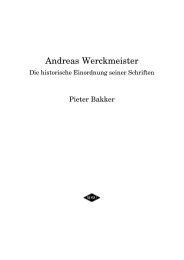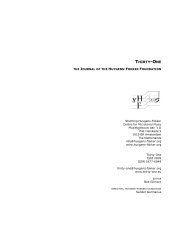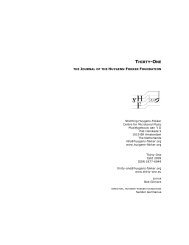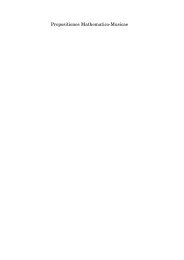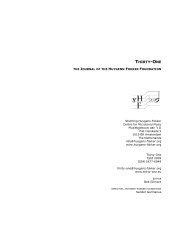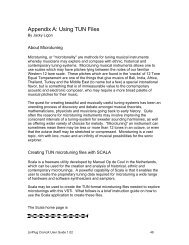Recent Organ Design Innovations and the 21st-century - Stichting ...
Recent Organ Design Innovations and the 21st-century - Stichting ...
Recent Organ Design Innovations and the 21st-century - Stichting ...
Create successful ePaper yourself
Turn your PDF publications into a flip-book with our unique Google optimized e-Paper software.
player to reprogram <strong>the</strong> keyboard to arrange <strong>the</strong> tones in any order. For example, <strong>the</strong> Obertonwerk<br />
could be programmed to arrange all of <strong>the</strong> tones in ascending pitch order, allowing a five-octave<br />
keyboard to play a span of one octave with more than sixty (unequal) subdivisions.<br />
While <strong>the</strong> stop specification is readily accessible <strong>and</strong> can easily be seen to draw from <strong>the</strong> whole<br />
range of <strong>the</strong> symphonic organ tradition, many of <strong>the</strong> most original innovations outside of <strong>the</strong><br />
Obertonwerk can be found in <strong>the</strong> mechanical <strong>and</strong> electronic interfacing of <strong>the</strong> instrument. Eschewing<br />
<strong>the</strong> traditional stop knob, tab, or button array, <strong>the</strong> console will feature two very large touchscreens on<br />
ei<strong>the</strong>r side, where <strong>the</strong> attendant stops can be activated. Though <strong>the</strong> organ contains elements of many<br />
symphonic organ styles, stops representing <strong>the</strong>se diverse traditions are not designed to be used<br />
toge<strong>the</strong>r. On <strong>the</strong> touchscreens one will be able to select <strong>the</strong> “French” organ, <strong>the</strong> “German” organ, or<br />
preprogram any kind of subset. Additionally, through <strong>the</strong> touchscreens one will be able to “draw on”<br />
any stop to any desired partial length. Partially drawing stops offers fine regulation of tuning, pitch, <strong>and</strong><br />
voicing <strong>and</strong> was a popular technique among composers of spectral organ music since <strong>the</strong> 1960s,<br />
including Ligeti, Hambraeus, <strong>and</strong> Scelsi. With <strong>the</strong> touchscreens one can partially draw a stop to any one<br />
of 128 steps <strong>and</strong> program it into <strong>the</strong> combination action. Generating a similar effect across <strong>the</strong> whole<br />
organ or a specific division, several Sperrventilen can likewise be set to open partway <strong>and</strong> can be<br />
adjusted in real time using <strong>the</strong> touchscreen graphical interface or through <strong>the</strong> Walze, offering a level of<br />
control far beyond <strong>the</strong> trial <strong>and</strong> error approximation techniques necessary in traditional mechanical<br />
actions.<br />
Though it boasts a massive mechanical action, <strong>the</strong> organ can also be played remotely, ei<strong>the</strong>r<br />
through integrated recording mechanisms, or by interfacing through any compatible computer. An<br />
electric action working in parallel with a fully mechanical stop <strong>and</strong> coupler action has never been<br />
attempted on an organ of this size <strong>and</strong> complexity. Peter Bengtson, a Swedish software designer,<br />
composer, <strong>and</strong> organist, is carrying out <strong>the</strong> programming of <strong>the</strong> instrument’s electronic components.<br />
37



